Cross-cultural Miscommunication (Chinese Business Etiquette)
VerifiedAdded on 2023/06/14
|9
|2119
|367
AI Summary
This essay report discusses the business etiquette for starting a business in China. It presents the strategies for implementing the business etiquette in China and evaluates the culture of China using Hofstede's Culture Dimensions.
Contribute Materials
Your contribution can guide someone’s learning journey. Share your
documents today.
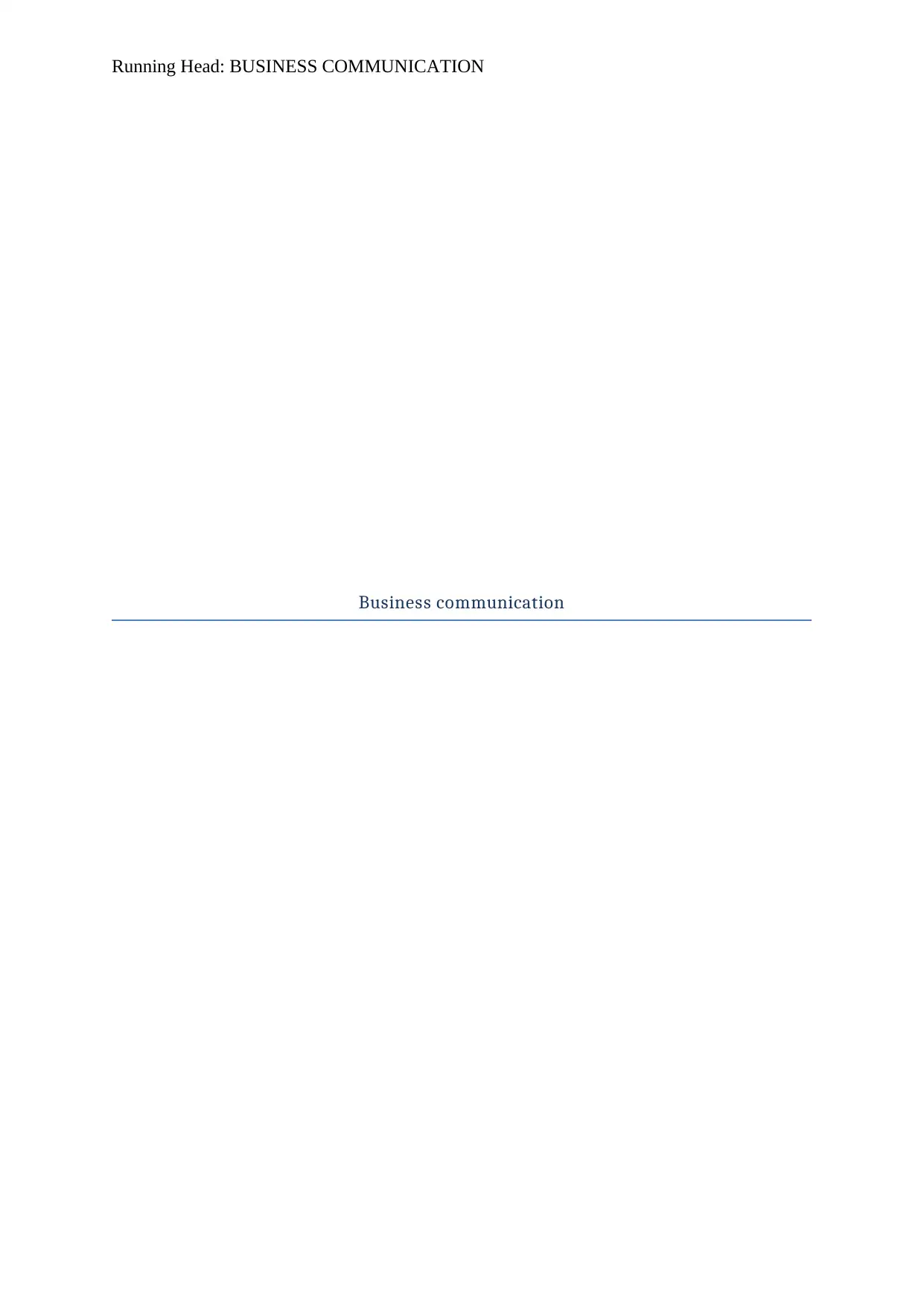
Running Head: BUSINESS COMMUNICATION
Business communication
Business communication
Secure Best Marks with AI Grader
Need help grading? Try our AI Grader for instant feedback on your assignments.
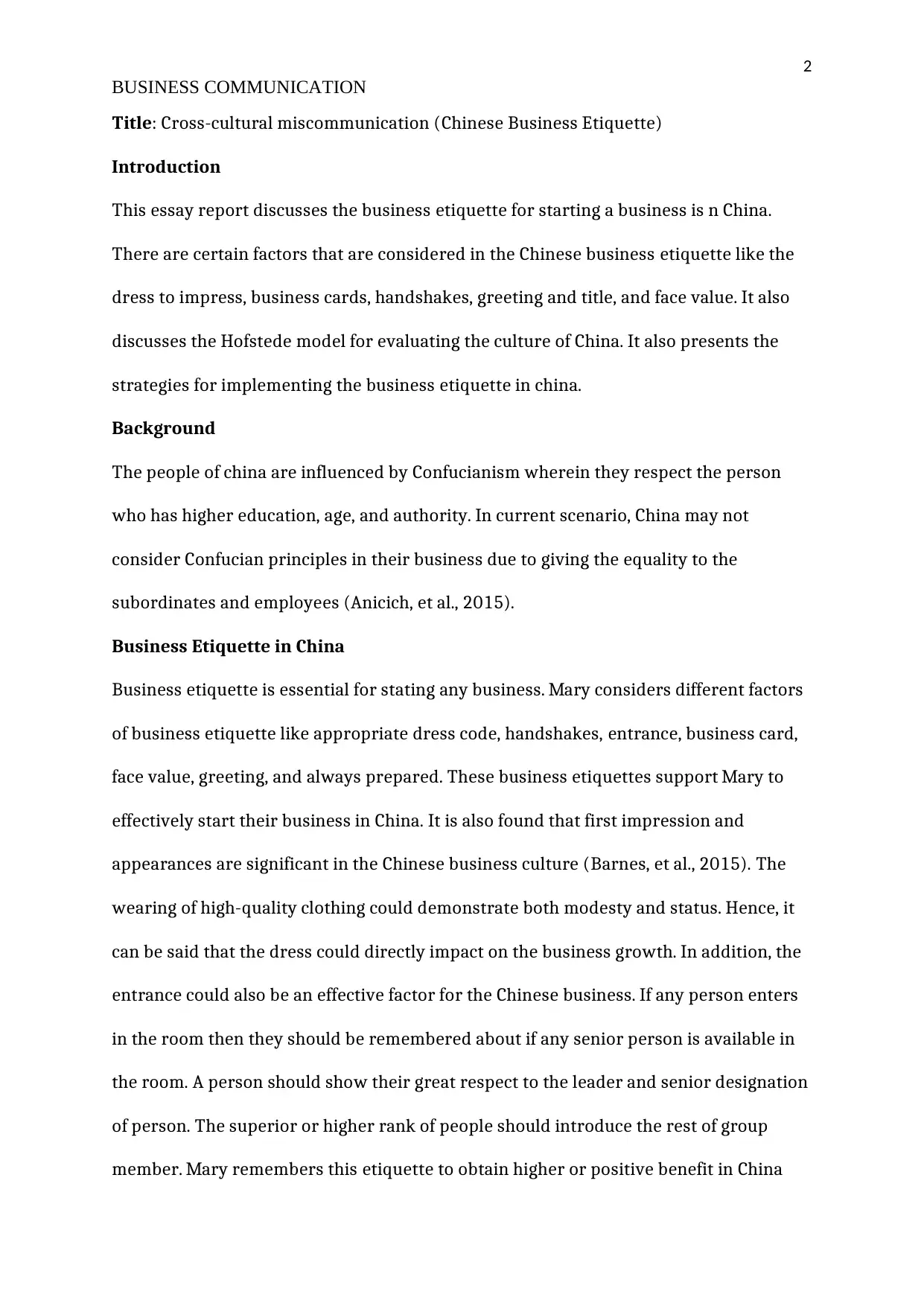
2
BUSINESS COMMUNICATION
Title: Cross-cultural miscommunication (Chinese Business Etiquette)
Introduction
This essay report discusses the business etiquette for starting a business is n China.
There are certain factors that are considered in the Chinese business etiquette like the
dress to impress, business cards, handshakes, greeting and title, and face value. It also
discusses the Hofstede model for evaluating the culture of China. It also presents the
strategies for implementing the business etiquette in china.
Background
The people of china are influenced by Confucianism wherein they respect the person
who has higher education, age, and authority. In current scenario, China may not
consider Confucian principles in their business due to giving the equality to the
subordinates and employees (Anicich, et al., 2015).
Business Etiquette in China
Business etiquette is essential for stating any business. Mary considers different factors
of business etiquette like appropriate dress code, handshakes, entrance, business card,
face value, greeting, and always prepared. These business etiquettes support Mary to
effectively start their business in China. It is also found that first impression and
appearances are significant in the Chinese business culture (Barnes, et al., 2015). The
wearing of high-quality clothing could demonstrate both modesty and status. Hence, it
can be said that the dress could directly impact on the business growth. In addition, the
entrance could also be an effective factor for the Chinese business. If any person enters
in the room then they should be remembered about if any senior person is available in
the room. A person should show their great respect to the leader and senior designation
of person. The superior or higher rank of people should introduce the rest of group
member. Mary remembers this etiquette to obtain higher or positive benefit in China
BUSINESS COMMUNICATION
Title: Cross-cultural miscommunication (Chinese Business Etiquette)
Introduction
This essay report discusses the business etiquette for starting a business is n China.
There are certain factors that are considered in the Chinese business etiquette like the
dress to impress, business cards, handshakes, greeting and title, and face value. It also
discusses the Hofstede model for evaluating the culture of China. It also presents the
strategies for implementing the business etiquette in china.
Background
The people of china are influenced by Confucianism wherein they respect the person
who has higher education, age, and authority. In current scenario, China may not
consider Confucian principles in their business due to giving the equality to the
subordinates and employees (Anicich, et al., 2015).
Business Etiquette in China
Business etiquette is essential for stating any business. Mary considers different factors
of business etiquette like appropriate dress code, handshakes, entrance, business card,
face value, greeting, and always prepared. These business etiquettes support Mary to
effectively start their business in China. It is also found that first impression and
appearances are significant in the Chinese business culture (Barnes, et al., 2015). The
wearing of high-quality clothing could demonstrate both modesty and status. Hence, it
can be said that the dress could directly impact on the business growth. In addition, the
entrance could also be an effective factor for the Chinese business. If any person enters
in the room then they should be remembered about if any senior person is available in
the room. A person should show their great respect to the leader and senior designation
of person. The superior or higher rank of people should introduce the rest of group
member. Mary remembers this etiquette to obtain higher or positive benefit in China
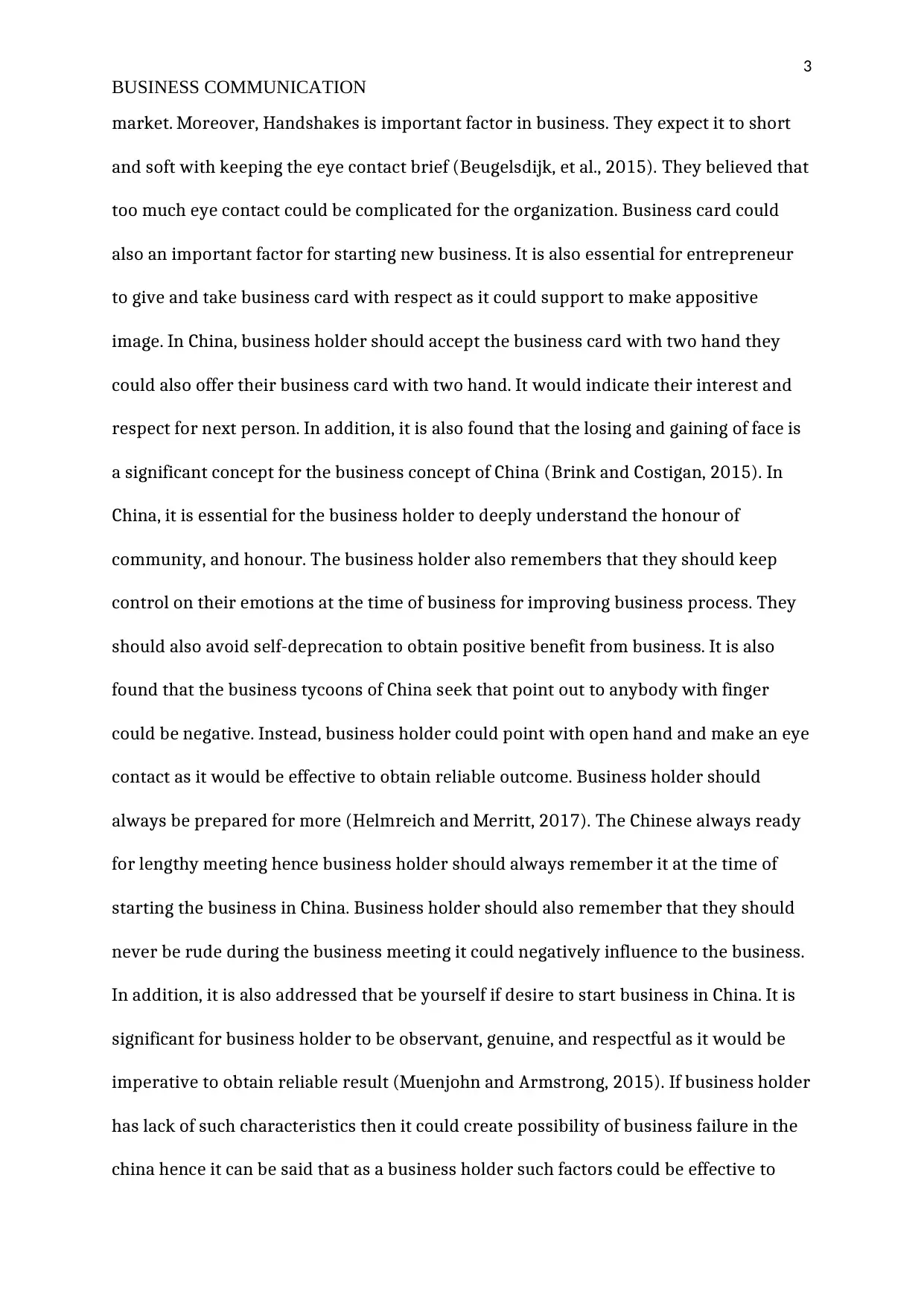
3
BUSINESS COMMUNICATION
market. Moreover, Handshakes is important factor in business. They expect it to short
and soft with keeping the eye contact brief (Beugelsdijk, et al., 2015). They believed that
too much eye contact could be complicated for the organization. Business card could
also an important factor for starting new business. It is also essential for entrepreneur
to give and take business card with respect as it could support to make appositive
image. In China, business holder should accept the business card with two hand they
could also offer their business card with two hand. It would indicate their interest and
respect for next person. In addition, it is also found that the losing and gaining of face is
a significant concept for the business concept of China (Brink and Costigan, 2015). In
China, it is essential for the business holder to deeply understand the honour of
community, and honour. The business holder also remembers that they should keep
control on their emotions at the time of business for improving business process. They
should also avoid self-deprecation to obtain positive benefit from business. It is also
found that the business tycoons of China seek that point out to anybody with finger
could be negative. Instead, business holder could point with open hand and make an eye
contact as it would be effective to obtain reliable outcome. Business holder should
always be prepared for more (Helmreich and Merritt, 2017). The Chinese always ready
for lengthy meeting hence business holder should always remember it at the time of
starting the business in China. Business holder should also remember that they should
never be rude during the business meeting it could negatively influence to the business.
In addition, it is also addressed that be yourself if desire to start business in China. It is
significant for business holder to be observant, genuine, and respectful as it would be
imperative to obtain reliable result (Muenjohn and Armstrong, 2015). If business holder
has lack of such characteristics then it could create possibility of business failure in the
china hence it can be said that as a business holder such factors could be effective to
BUSINESS COMMUNICATION
market. Moreover, Handshakes is important factor in business. They expect it to short
and soft with keeping the eye contact brief (Beugelsdijk, et al., 2015). They believed that
too much eye contact could be complicated for the organization. Business card could
also an important factor for starting new business. It is also essential for entrepreneur
to give and take business card with respect as it could support to make appositive
image. In China, business holder should accept the business card with two hand they
could also offer their business card with two hand. It would indicate their interest and
respect for next person. In addition, it is also found that the losing and gaining of face is
a significant concept for the business concept of China (Brink and Costigan, 2015). In
China, it is essential for the business holder to deeply understand the honour of
community, and honour. The business holder also remembers that they should keep
control on their emotions at the time of business for improving business process. They
should also avoid self-deprecation to obtain positive benefit from business. It is also
found that the business tycoons of China seek that point out to anybody with finger
could be negative. Instead, business holder could point with open hand and make an eye
contact as it would be effective to obtain reliable outcome. Business holder should
always be prepared for more (Helmreich and Merritt, 2017). The Chinese always ready
for lengthy meeting hence business holder should always remember it at the time of
starting the business in China. Business holder should also remember that they should
never be rude during the business meeting it could negatively influence to the business.
In addition, it is also addressed that be yourself if desire to start business in China. It is
significant for business holder to be observant, genuine, and respectful as it would be
imperative to obtain reliable result (Muenjohn and Armstrong, 2015). If business holder
has lack of such characteristics then it could create possibility of business failure in the
china hence it can be said that as a business holder such factors could be effective to

4
BUSINESS COMMUNICATION
obtain reliable result. In addition, it is also addressed that greeting could play a
significant role in the business. In the current business scenario, a handshake is
becoming a famous way to meet women and men in the business setting, it does not
matter what their age. Chinese respect the seniors and older hence business holder
should always remember if they want to start their business in China. It is also
remembered that people business holder exchange their business card with the senior
or higher rank people before seating (Post, 2017).
HOFSTEDE'S CULTURE DIMENSIONS
Hofstede's Culture dimension is supportive for critically evaluate business culture and
examine the success of business in the particular area. There are certain factors that
included in this model like power distance, individualism, masculine, uncertainty
avoidance, indulgence, and long-term orientation. These factors are discussed as below:
(Source: Hofstead insight, 2018)
Power Distance
The power distance is identified as the amount of power between higher and lower
ranked employee within the organization. From the application of Hofstead model, it is
found that the power distance is 80, which means the higher inequality of power. The
higher power distance of county demonstrates that people do not question in oppose to
BUSINESS COMMUNICATION
obtain reliable result. In addition, it is also addressed that greeting could play a
significant role in the business. In the current business scenario, a handshake is
becoming a famous way to meet women and men in the business setting, it does not
matter what their age. Chinese respect the seniors and older hence business holder
should always remember if they want to start their business in China. It is also
remembered that people business holder exchange their business card with the senior
or higher rank people before seating (Post, 2017).
HOFSTEDE'S CULTURE DIMENSIONS
Hofstede's Culture dimension is supportive for critically evaluate business culture and
examine the success of business in the particular area. There are certain factors that
included in this model like power distance, individualism, masculine, uncertainty
avoidance, indulgence, and long-term orientation. These factors are discussed as below:
(Source: Hofstead insight, 2018)
Power Distance
The power distance is identified as the amount of power between higher and lower
ranked employee within the organization. From the application of Hofstead model, it is
found that the power distance is 80, which means the higher inequality of power. The
higher power distance of county demonstrates that people do not question in oppose to
Secure Best Marks with AI Grader
Need help grading? Try our AI Grader for instant feedback on your assignments.
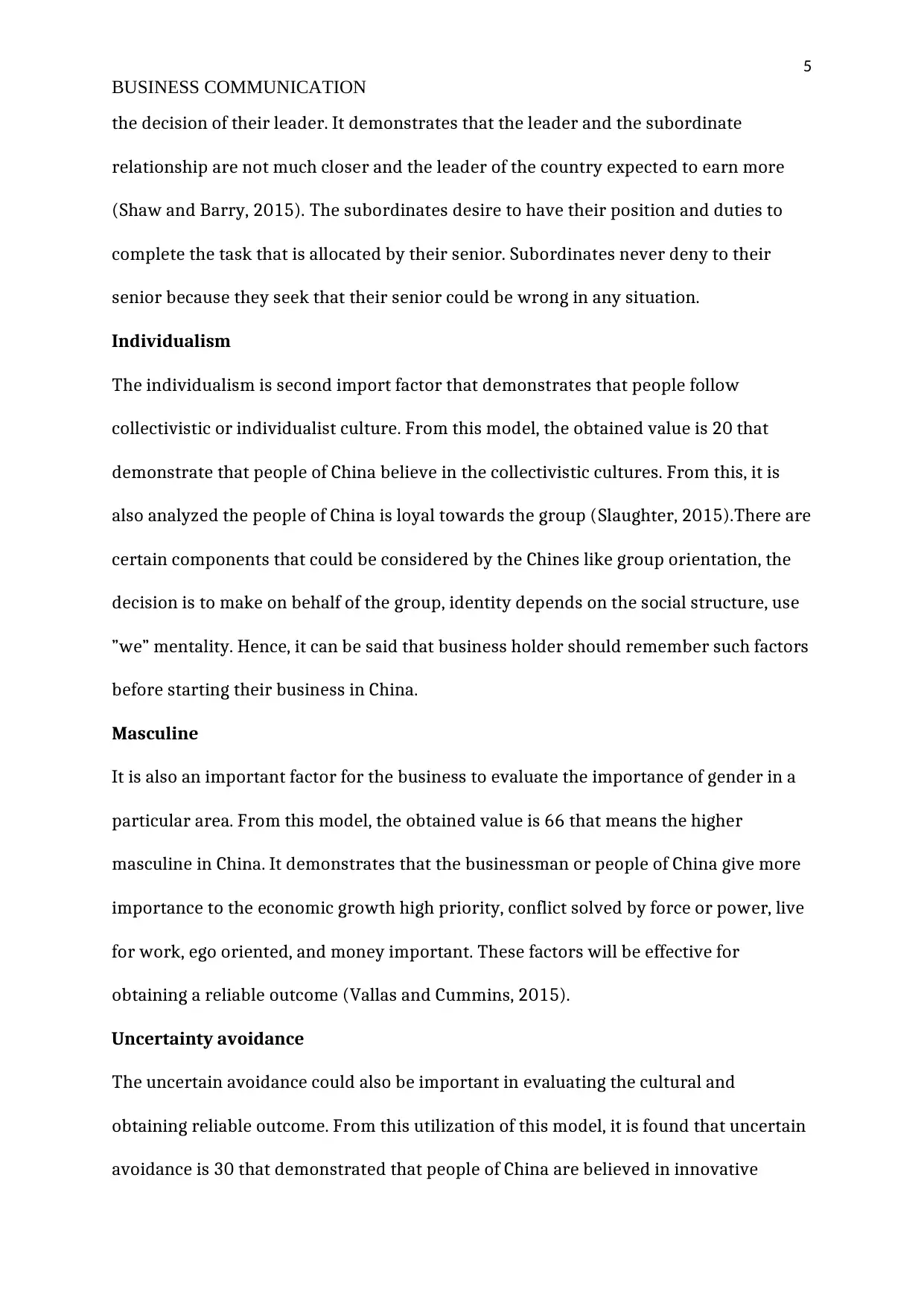
5
BUSINESS COMMUNICATION
the decision of their leader. It demonstrates that the leader and the subordinate
relationship are not much closer and the leader of the country expected to earn more
(Shaw and Barry, 2015). The subordinates desire to have their position and duties to
complete the task that is allocated by their senior. Subordinates never deny to their
senior because they seek that their senior could be wrong in any situation.
Individualism
The individualism is second import factor that demonstrates that people follow
collectivistic or individualist culture. From this model, the obtained value is 20 that
demonstrate that people of China believe in the collectivistic cultures. From this, it is
also analyzed the people of China is loyal towards the group (Slaughter, 2015).There are
certain components that could be considered by the Chines like group orientation, the
decision is to make on behalf of the group, identity depends on the social structure, use
”we” mentality. Hence, it can be said that business holder should remember such factors
before starting their business in China.
Masculine
It is also an important factor for the business to evaluate the importance of gender in a
particular area. From this model, the obtained value is 66 that means the higher
masculine in China. It demonstrates that the businessman or people of China give more
importance to the economic growth high priority, conflict solved by force or power, live
for work, ego oriented, and money important. These factors will be effective for
obtaining a reliable outcome (Vallas and Cummins, 2015).
Uncertainty avoidance
The uncertain avoidance could also be important in evaluating the cultural and
obtaining reliable outcome. From this utilization of this model, it is found that uncertain
avoidance is 30 that demonstrated that people of China are believed in innovative
BUSINESS COMMUNICATION
the decision of their leader. It demonstrates that the leader and the subordinate
relationship are not much closer and the leader of the country expected to earn more
(Shaw and Barry, 2015). The subordinates desire to have their position and duties to
complete the task that is allocated by their senior. Subordinates never deny to their
senior because they seek that their senior could be wrong in any situation.
Individualism
The individualism is second import factor that demonstrates that people follow
collectivistic or individualist culture. From this model, the obtained value is 20 that
demonstrate that people of China believe in the collectivistic cultures. From this, it is
also analyzed the people of China is loyal towards the group (Slaughter, 2015).There are
certain components that could be considered by the Chines like group orientation, the
decision is to make on behalf of the group, identity depends on the social structure, use
”we” mentality. Hence, it can be said that business holder should remember such factors
before starting their business in China.
Masculine
It is also an important factor for the business to evaluate the importance of gender in a
particular area. From this model, the obtained value is 66 that means the higher
masculine in China. It demonstrates that the businessman or people of China give more
importance to the economic growth high priority, conflict solved by force or power, live
for work, ego oriented, and money important. These factors will be effective for
obtaining a reliable outcome (Vallas and Cummins, 2015).
Uncertainty avoidance
The uncertain avoidance could also be important in evaluating the cultural and
obtaining reliable outcome. From this utilization of this model, it is found that uncertain
avoidance is 30 that demonstrated that people of China are believed in innovative
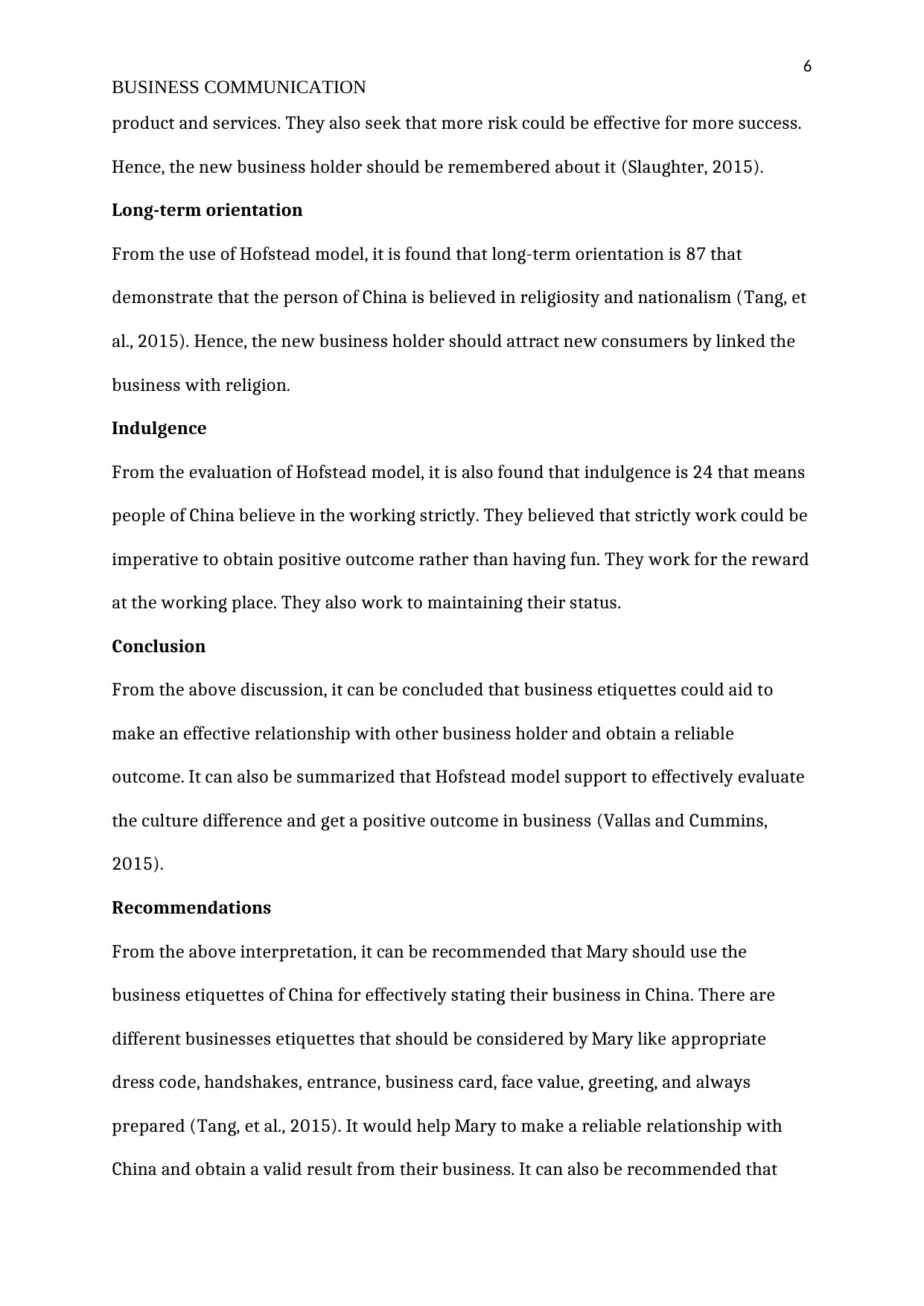
6
BUSINESS COMMUNICATION
product and services. They also seek that more risk could be effective for more success.
Hence, the new business holder should be remembered about it (Slaughter, 2015).
Long-term orientation
From the use of Hofstead model, it is found that long-term orientation is 87 that
demonstrate that the person of China is believed in religiosity and nationalism (Tang, et
al., 2015). Hence, the new business holder should attract new consumers by linked the
business with religion.
Indulgence
From the evaluation of Hofstead model, it is also found that indulgence is 24 that means
people of China believe in the working strictly. They believed that strictly work could be
imperative to obtain positive outcome rather than having fun. They work for the reward
at the working place. They also work to maintaining their status.
Conclusion
From the above discussion, it can be concluded that business etiquettes could aid to
make an effective relationship with other business holder and obtain a reliable
outcome. It can also be summarized that Hofstead model support to effectively evaluate
the culture difference and get a positive outcome in business (Vallas and Cummins,
2015).
Recommendations
From the above interpretation, it can be recommended that Mary should use the
business etiquettes of China for effectively stating their business in China. There are
different businesses etiquettes that should be considered by Mary like appropriate
dress code, handshakes, entrance, business card, face value, greeting, and always
prepared (Tang, et al., 2015). It would help Mary to make a reliable relationship with
China and obtain a valid result from their business. It can also be recommended that
BUSINESS COMMUNICATION
product and services. They also seek that more risk could be effective for more success.
Hence, the new business holder should be remembered about it (Slaughter, 2015).
Long-term orientation
From the use of Hofstead model, it is found that long-term orientation is 87 that
demonstrate that the person of China is believed in religiosity and nationalism (Tang, et
al., 2015). Hence, the new business holder should attract new consumers by linked the
business with religion.
Indulgence
From the evaluation of Hofstead model, it is also found that indulgence is 24 that means
people of China believe in the working strictly. They believed that strictly work could be
imperative to obtain positive outcome rather than having fun. They work for the reward
at the working place. They also work to maintaining their status.
Conclusion
From the above discussion, it can be concluded that business etiquettes could aid to
make an effective relationship with other business holder and obtain a reliable
outcome. It can also be summarized that Hofstead model support to effectively evaluate
the culture difference and get a positive outcome in business (Vallas and Cummins,
2015).
Recommendations
From the above interpretation, it can be recommended that Mary should use the
business etiquettes of China for effectively stating their business in China. There are
different businesses etiquettes that should be considered by Mary like appropriate
dress code, handshakes, entrance, business card, face value, greeting, and always
prepared (Tang, et al., 2015). It would help Mary to make a reliable relationship with
China and obtain a valid result from their business. It can also be recommended that

7
BUSINESS COMMUNICATION
Mary should use Hofstead model as it could support to critically analysis the culture of
China. From the learning of Hoftead model, Mary would be capable to effectively start
their business and get a reliable outcome.
BUSINESS COMMUNICATION
Mary should use Hofstead model as it could support to critically analysis the culture of
China. From the learning of Hoftead model, Mary would be capable to effectively start
their business and get a reliable outcome.
Paraphrase This Document
Need a fresh take? Get an instant paraphrase of this document with our AI Paraphraser
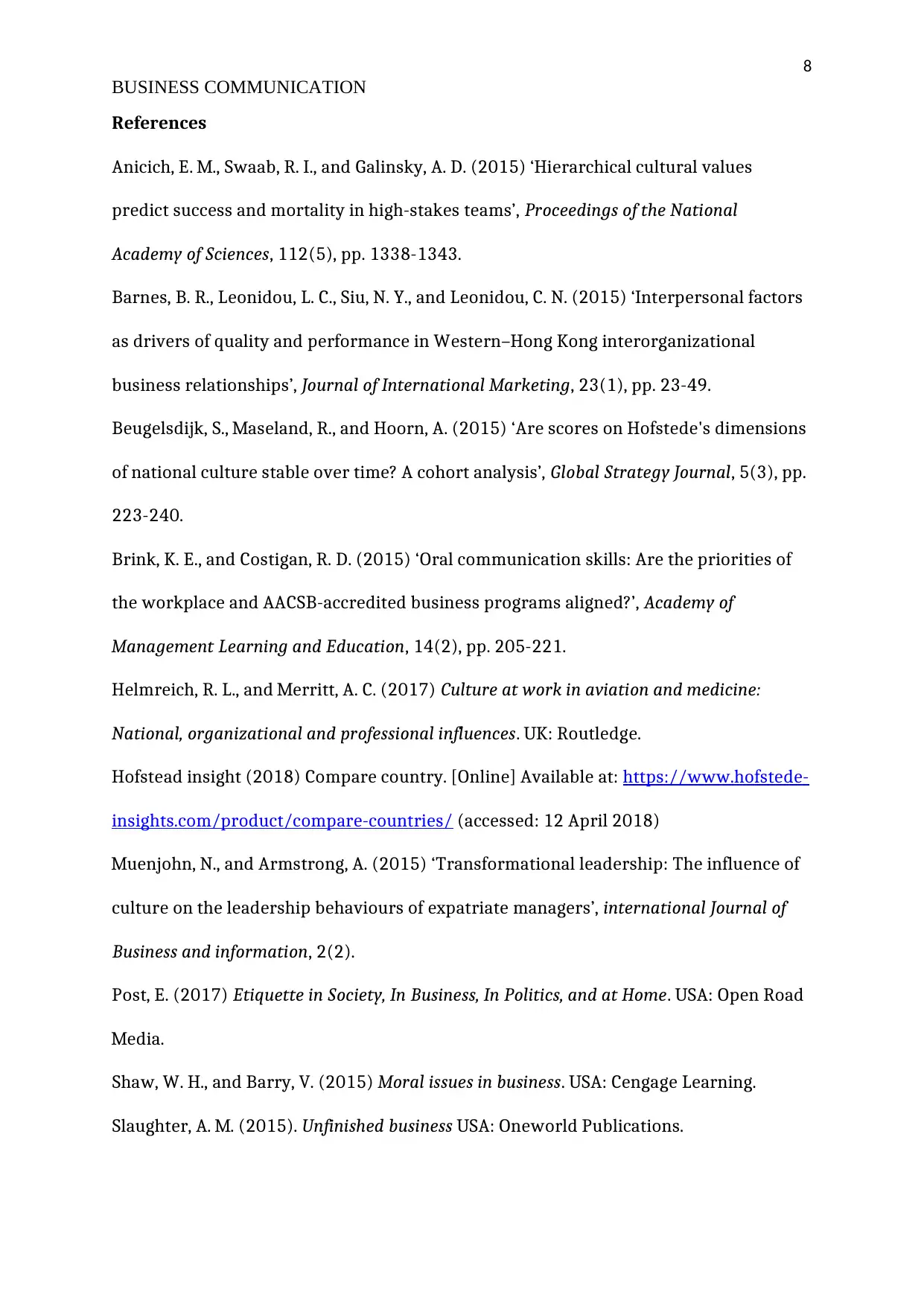
8
BUSINESS COMMUNICATION
References
Anicich, E. M., Swaab, R. I., and Galinsky, A. D. (2015) ‘Hierarchical cultural values
predict success and mortality in high-stakes teams’, Proceedings of the National
Academy of Sciences, 112(5), pp. 1338-1343.
Barnes, B. R., Leonidou, L. C., Siu, N. Y., and Leonidou, C. N. (2015) ‘Interpersonal factors
as drivers of quality and performance in Western–Hong Kong interorganizational
business relationships’, Journal of International Marketing, 23(1), pp. 23-49.
Beugelsdijk, S., Maseland, R., and Hoorn, A. (2015) ‘Are scores on Hofstede's dimensions
of national culture stable over time? A cohort analysis’, Global Strategy Journal, 5(3), pp.
223-240.
Brink, K. E., and Costigan, R. D. (2015) ‘Oral communication skills: Are the priorities of
the workplace and AACSB-accredited business programs aligned?’, Academy of
Management Learning and Education, 14(2), pp. 205-221.
Helmreich, R. L., and Merritt, A. C. (2017) Culture at work in aviation and medicine:
National, organizational and professional influences. UK: Routledge.
Hofstead insight (2018) Compare country. [Online] Available at: https://www.hofstede-
insights.com/product/compare-countries/ (accessed: 12 April 2018)
Muenjohn, N., and Armstrong, A. (2015) ‘Transformational leadership: The influence of
culture on the leadership behaviours of expatriate managers’, international Journal of
Business and information, 2(2).
Post, E. (2017) Etiquette in Society, In Business, In Politics, and at Home. USA: Open Road
Media.
Shaw, W. H., and Barry, V. (2015) Moral issues in business. USA: Cengage Learning.
Slaughter, A. M. (2015). Unfinished business USA: Oneworld Publications.
BUSINESS COMMUNICATION
References
Anicich, E. M., Swaab, R. I., and Galinsky, A. D. (2015) ‘Hierarchical cultural values
predict success and mortality in high-stakes teams’, Proceedings of the National
Academy of Sciences, 112(5), pp. 1338-1343.
Barnes, B. R., Leonidou, L. C., Siu, N. Y., and Leonidou, C. N. (2015) ‘Interpersonal factors
as drivers of quality and performance in Western–Hong Kong interorganizational
business relationships’, Journal of International Marketing, 23(1), pp. 23-49.
Beugelsdijk, S., Maseland, R., and Hoorn, A. (2015) ‘Are scores on Hofstede's dimensions
of national culture stable over time? A cohort analysis’, Global Strategy Journal, 5(3), pp.
223-240.
Brink, K. E., and Costigan, R. D. (2015) ‘Oral communication skills: Are the priorities of
the workplace and AACSB-accredited business programs aligned?’, Academy of
Management Learning and Education, 14(2), pp. 205-221.
Helmreich, R. L., and Merritt, A. C. (2017) Culture at work in aviation and medicine:
National, organizational and professional influences. UK: Routledge.
Hofstead insight (2018) Compare country. [Online] Available at: https://www.hofstede-
insights.com/product/compare-countries/ (accessed: 12 April 2018)
Muenjohn, N., and Armstrong, A. (2015) ‘Transformational leadership: The influence of
culture on the leadership behaviours of expatriate managers’, international Journal of
Business and information, 2(2).
Post, E. (2017) Etiquette in Society, In Business, In Politics, and at Home. USA: Open Road
Media.
Shaw, W. H., and Barry, V. (2015) Moral issues in business. USA: Cengage Learning.
Slaughter, A. M. (2015). Unfinished business USA: Oneworld Publications.
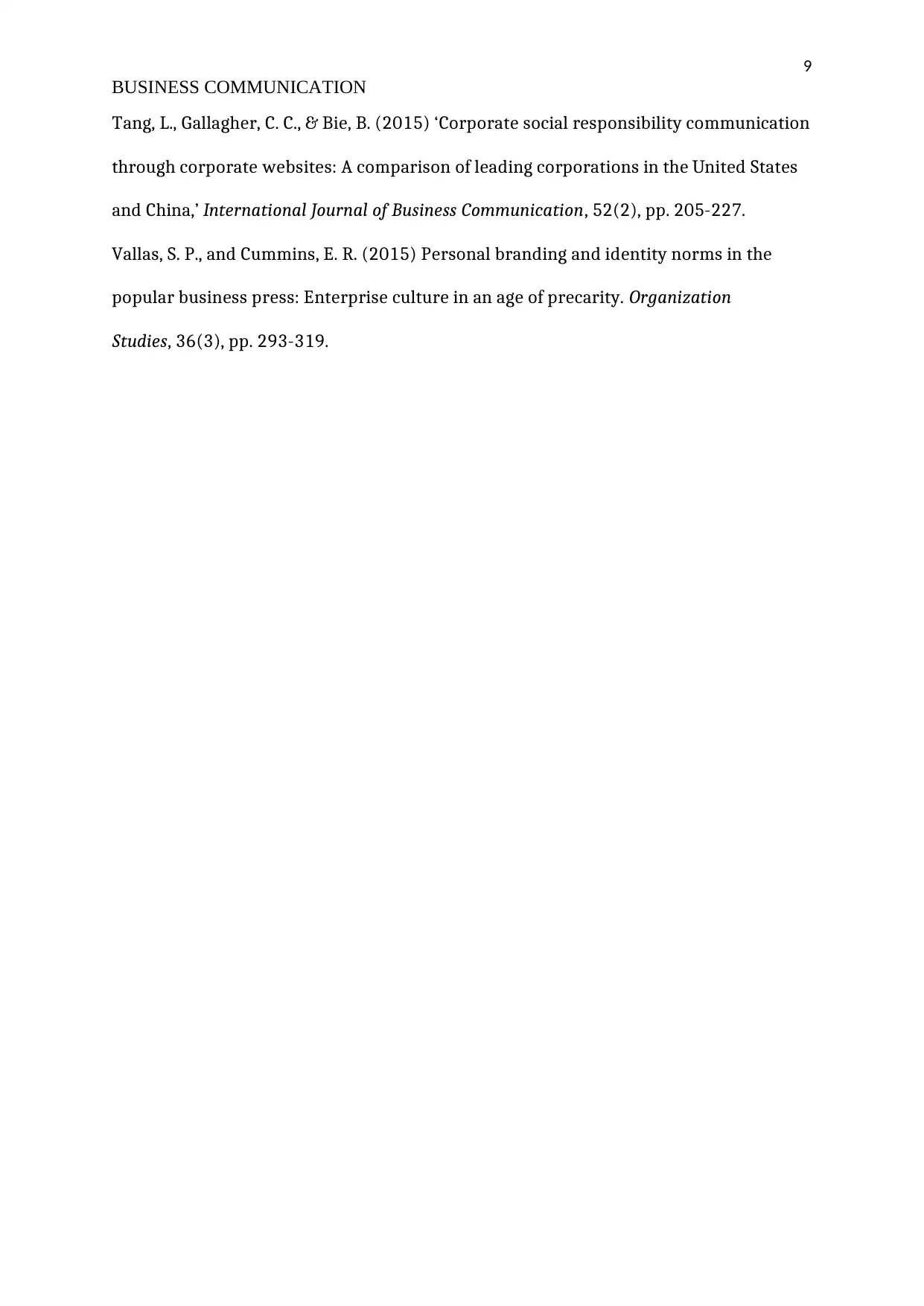
9
BUSINESS COMMUNICATION
Tang, L., Gallagher, C. C., & Bie, B. (2015) ‘Corporate social responsibility communication
through corporate websites: A comparison of leading corporations in the United States
and China,’ International Journal of Business Communication, 52(2), pp. 205-227.
Vallas, S. P., and Cummins, E. R. (2015) Personal branding and identity norms in the
popular business press: Enterprise culture in an age of precarity. Organization
Studies, 36(3), pp. 293-319.
BUSINESS COMMUNICATION
Tang, L., Gallagher, C. C., & Bie, B. (2015) ‘Corporate social responsibility communication
through corporate websites: A comparison of leading corporations in the United States
and China,’ International Journal of Business Communication, 52(2), pp. 205-227.
Vallas, S. P., and Cummins, E. R. (2015) Personal branding and identity norms in the
popular business press: Enterprise culture in an age of precarity. Organization
Studies, 36(3), pp. 293-319.
1 out of 9
Related Documents
Your All-in-One AI-Powered Toolkit for Academic Success.
+13062052269
info@desklib.com
Available 24*7 on WhatsApp / Email
![[object Object]](/_next/static/media/star-bottom.7253800d.svg)
Unlock your academic potential
© 2024 | Zucol Services PVT LTD | All rights reserved.





